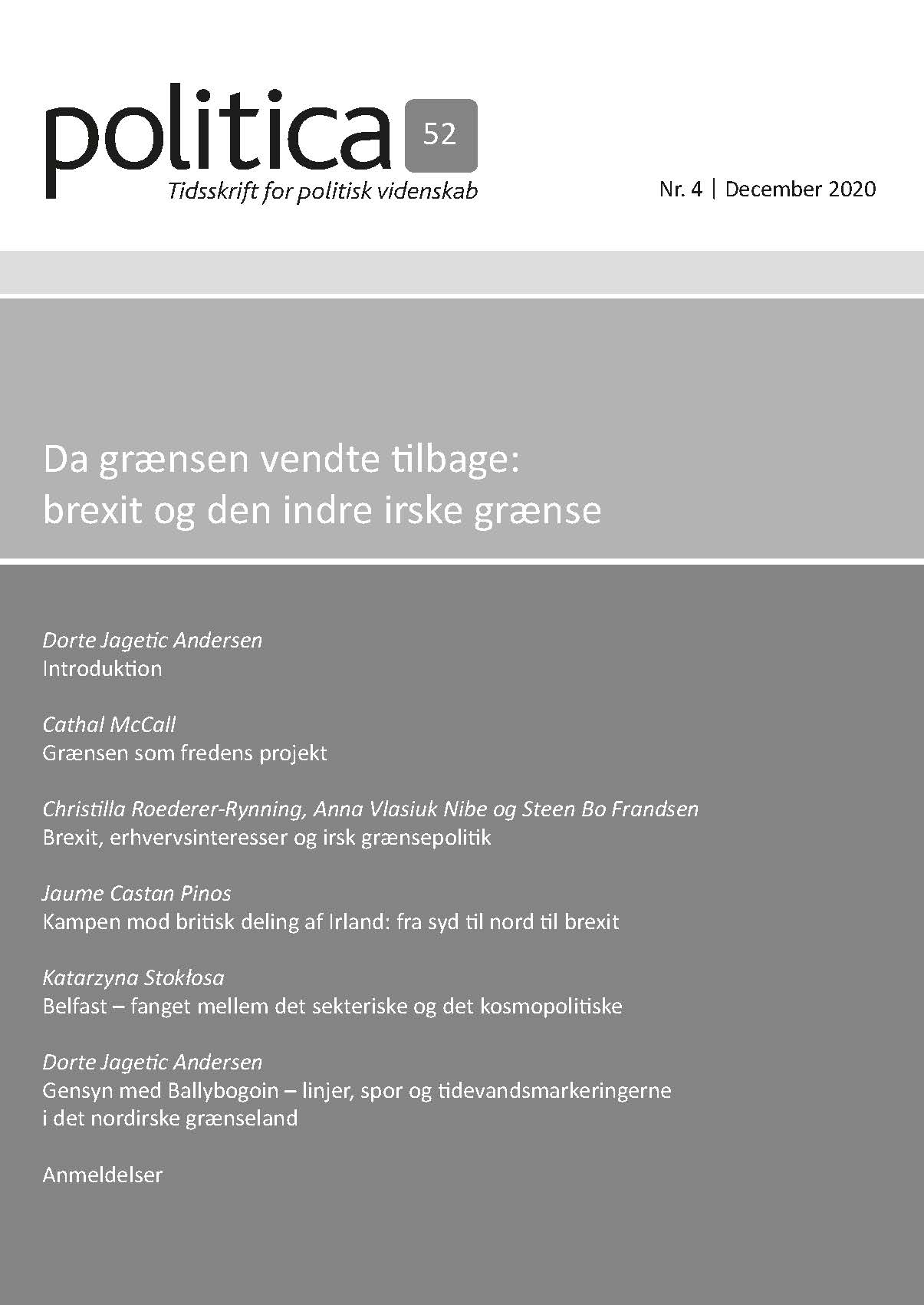Belfast – fanget mellem det sekteriske og det kosmopolitiske
DOI:
https://doi.org/10.7146/politica.v52i4.130836Nøgleord:
Belfast, delte byer, sekterisk deling, fysisk deling, social delingResumé
Delte byer er efterhånden et særsyn i europæisk sammenhæng. Fænomenet er hovedsageligt resultat af geopolitiske forandringer, der har præget Europa de seneste to århundreder og udspringer af krige. Ikke mange har rod i en imperial fortid og de økonomiske skel mellem sociale grupper, som man ser det i Belfast. De mest dramatiske konsekvenser af delte byer er fysiske, dvs. voldelige konflikter og tab af liv. Manglende interaktion gør det vanskeligt at skabe fælles forudsætninger, selv mange år efter de voldelige konflikter er overstået. Artiklen undersøger de sociale barrierer, der opstod som følge af ”the troubles” – dvs. fra 1969 og fremefter – sammen med de fysiske barrierer og delinger, der præger byrummet i Belfast i dag. Det centrale spørgsmål er, om byens indbyggere taler eller er parate til at tale på basis af fælles forudsætninger og fortælle de samme historier og diskurser om delingerne, der har præget byen igennem næsten 50 år. Eller er kløften stadig en del af det sociale setup i dagens Belfast?
Referencer
Andersen, Dorte Jagetic (2020). Gensyn med Ballybogoin – linjer, spor og tidevandsmarkeringerne i det nordirske grænseland. Politica 52 (4): 420-437.
Ardoyne Commemoration Project (2002). Ardoyne: The Untold Truth. Belfast: Beyond the Pale.
Bardon, Jonathan (1992). A history of Ulster. Belfast: Blackstaff.
Bergström, Tomas (2015). Belfast: Troubles after the Troubles?, pp. 151-171 i Annika Björkdahl og Lisa Strömbom (red.), Divided Cities: Governing Diversity. Lund: Nordic Academic Press.
Björkdahl, Annika og Lisa Strömbom (2015). Contestation in divided cities, pp. 235-245 i Annika Björkdahl og Lisa Strömbom (red.), Divided Cities: Governing Diversity. Lund: Nordic Academic Press.
Brewer, John D. (2019). The sociology of the Northern Irish Peace Process, pp. 271-289 i Charles I. Armstrong, David Herbert og Jan Erik Mustad (red.), The Legacy of the Good Friday Agreement. Northern Irish Politics, Culture and Art after 1998. London: Palgrave.
Byrne, Jonny og Cathy Gormley-Heenan (2014). Beyond the walls: Dismantling Belfast’s conflict architecture. City: Analysis of Urban Change, Theory, Action 18 (4-5): 447-454.
Byrne, Sean og Neal Carter (1996). Social cubism: Six social forces of ethnoterritorial politics in Northern Ireland and Quebec. Peace and Conflict Studies 3 (2): article 5.
Calame, Jon og Esther Charlesworth (2009). Divided Cities. Belfast, Beirut, Jerusalem, Mostar, and Nicosia. Philadelphia: University of Pennsylvania Press.
Census (2011). https://www.ons.gov.uk/census/2011census (9. september 2020).
Coakley, John, John Garry, Neil Matthews og Brendan O’Leary (2018). Party images in Northern Ireland: evidence from a new dataset. https://doi.org/10.1080/07907184.2018.1499621 (9. september 2020).
Dolan, Anne (2003). Commemorating the Irish Civil War. History and Memory, 1923-2000. Cambridge: Cambridge University Press.
Donnan, Hastings og Neil Jarman (2017). Ordinary everyday walls: Normalising exception in segregated Belfast, pp. 238-260 i Alberto Gasparini (red.), The Walls Between Conflict and Peace. Leiden: Brill.
Fay, Marie-Therese, Mike Morrissey og Marie Smith (1999). Northern Ireland’s troubles: The human costs. London: Pluto Press.
Fraser, T. G. (2000). Ireland in conflict, 1922-1998. London: Routledge.
Gilligan, Chris og Jonathan Tonge (1997). Peace or War? Understanding the Peace Process in Northern Ireland. Abingdon: Routledge.
Gormley-Heenan, Cathy, Jonny Byrne og Gillian Robinson (2013). The Berlin walls of Belfast. British Politics 8: 357-372.
Gray, Ann Marie et al. (2018). Northern Ireland Peace Monitoring Report (2018), Number Five. Ulster University https://www.community-relations.org.uk/sites/crc/files/media-files/NIPMR%205%20%282%29%20new%20version.pdf (9. september 2020).
Hayes, Bernadette C., Ian McAllister og Lizanne Dowds (2019). In Search of the Middle Ground: Integrated Education and Northern Ireland Politics, Number 42, January 2006 https://www.ark.ac.uk/publications/updates/update42.pdf (9. september 2020).
Herbert, David (2019). Legacies of 1998: What kind of social peace has developed in Northern Ireland? Social attitudes, inequalities, and territorialities, pp. 249-270 i Charles Armstrong, David Herbert og Jan Erik Mustad (red.), The Legacy of the Good Friday Agreement: Northern Irish Politics, Culture and Art after 1998. London: Palgrave.
Jajeśniak-Quast, Dagmara og Katarzyna Stokłosa (2000). Geteilte Städte an Oder und Neiße. Frankfurt (Oder) – Słubice, Guben – Gubin und Görlitz – Zgorzelec, 1945–1995. Berlin: Arno Spitz
Kennedy, Liam og Philipp Ollerenshaw (2013). Ulster since 1600. Politics, Economy, and Society. Oxford: Oxford University Press
McCall, Cathal (2014). The European Union and Peacebuilding. The Cross-Border Dimension. Basingstoke: Palgrave.
McCall, Cathal (2020). Grænsen som fredens projekt. Politica 52 (4): 350-362.
McKeown, Shelley (2013). Identity, Segregation and Peace-Building in Northern Ireland. A Social Psychological Perspective. Basingstoke: Palgrave.
Miller, David (2014). Rethinking Northern Ireland: Culture, Ideology and Colonialism. Abingdon: Routledge.
Morrissey, Sinéad (2013). Parallax. Manchester: Carcanet Press Ltd.
Murtagh, Brendan (1995). Image making versus reality: Ethnic division and the planning challenge of Belfast’s peacelines, pp. 209-230 i William J.V. Neill, Diana S. Fitzsimons og Brendan Murthag (red), The Politics of Territory: Policy and Segregation in Northern Ireland. Houndsmille: Palgrave.
Nagle, John (2009). Sites of social centrality and segregation. Lefebre in Belfast, a “divided city”, Antipode 41 (2): 326-347.
Rosland, Sissel (2019). Making hope and history rhyme? Dealing with division and the past in Northern Ireland after the Good Friday Agreement, pp. 153-172 i Charles Armstrong, David Herbert og Jan Erik Mustad (red.), The Legacy of the Good Friday Agreement: Northern Irish Politics, Culture and Art after 1998. London: Palgrave.
Schultz, Helga (2002). Twin towns on the border as laboratories of European integration, F.I.T. Discussion Paper 4.
Stokłosa, Katarzyna (2017). Twin towns in Eastern Europe: On the way from bordering to the cross-border identity?, pp. 307-315 i Elżbieta Opiłowska, Zbigniew Kurcz og Jochen Roose (red.), Advances in European Borderlands Studies. Baden-Baden: Nomos.
Thomson, Jennifer (2019). Feminising politics, politicising feminism? Women in post-conflict Northern Irish politics. British Politics 14 (2): 181-197.
Topping, Margaret og Colm M. Cavanagh (2016). Integrating Education in Northern Ireland: Celebrating Inclusiveness and Fostering Innovation on Our Schools (November 2016). Belfast: DE. https://www.ief.org.uk/wp-content/uploads/2017/03/Integrating-Education-Report.pdf (9. september 2020).
Yarwood, John (2006). The Dublin-Belfast Development Corridor: Ireland`s Mega-City Region? Abingdon: Ashgate.
Downloads
Publiceret
Citation/Eksport
Nummer
Sektion
Licens
LicensOphavsretten tilhører Politica. Materialet må ikke bruges eller distribueres i kommercielt øjemed.





